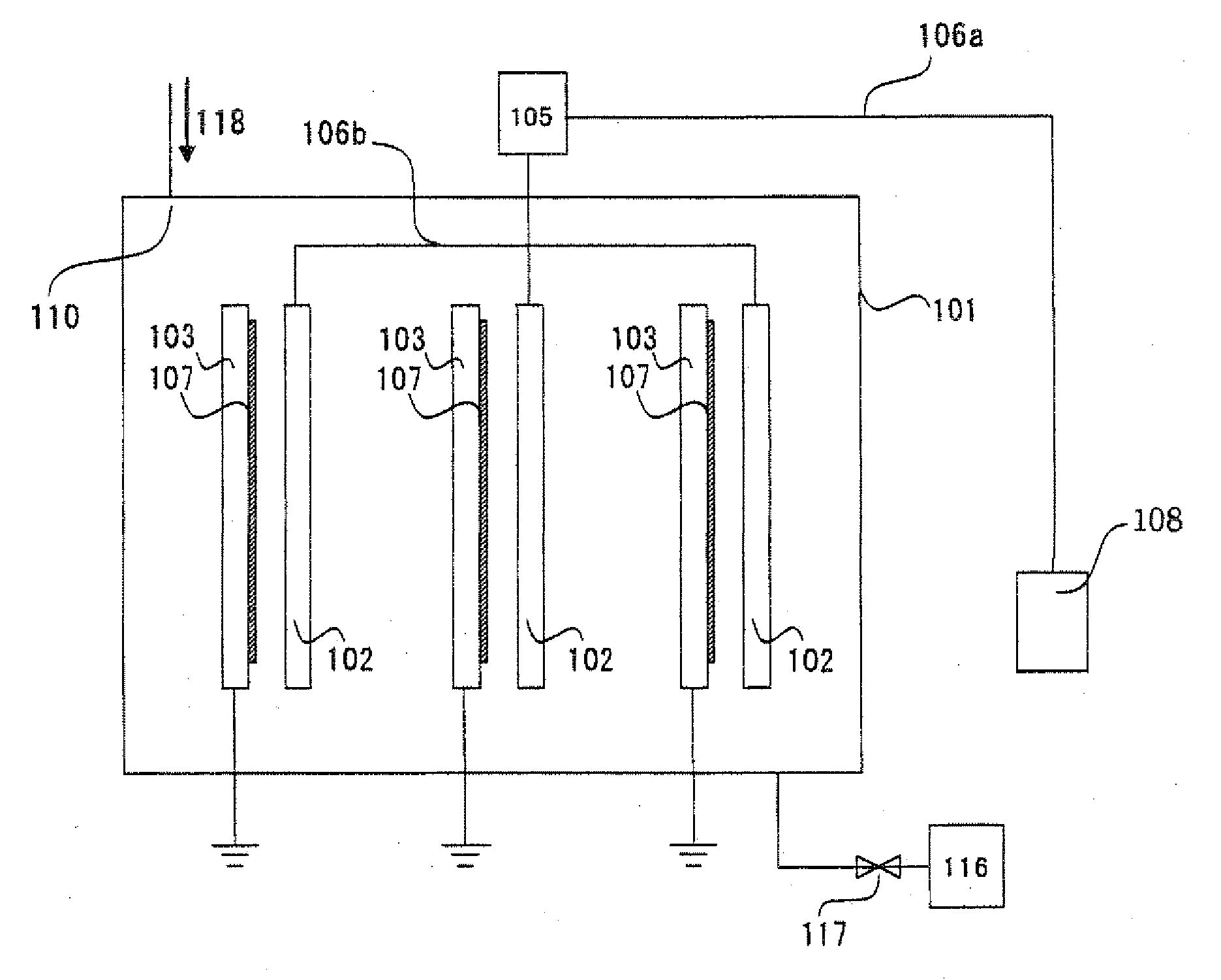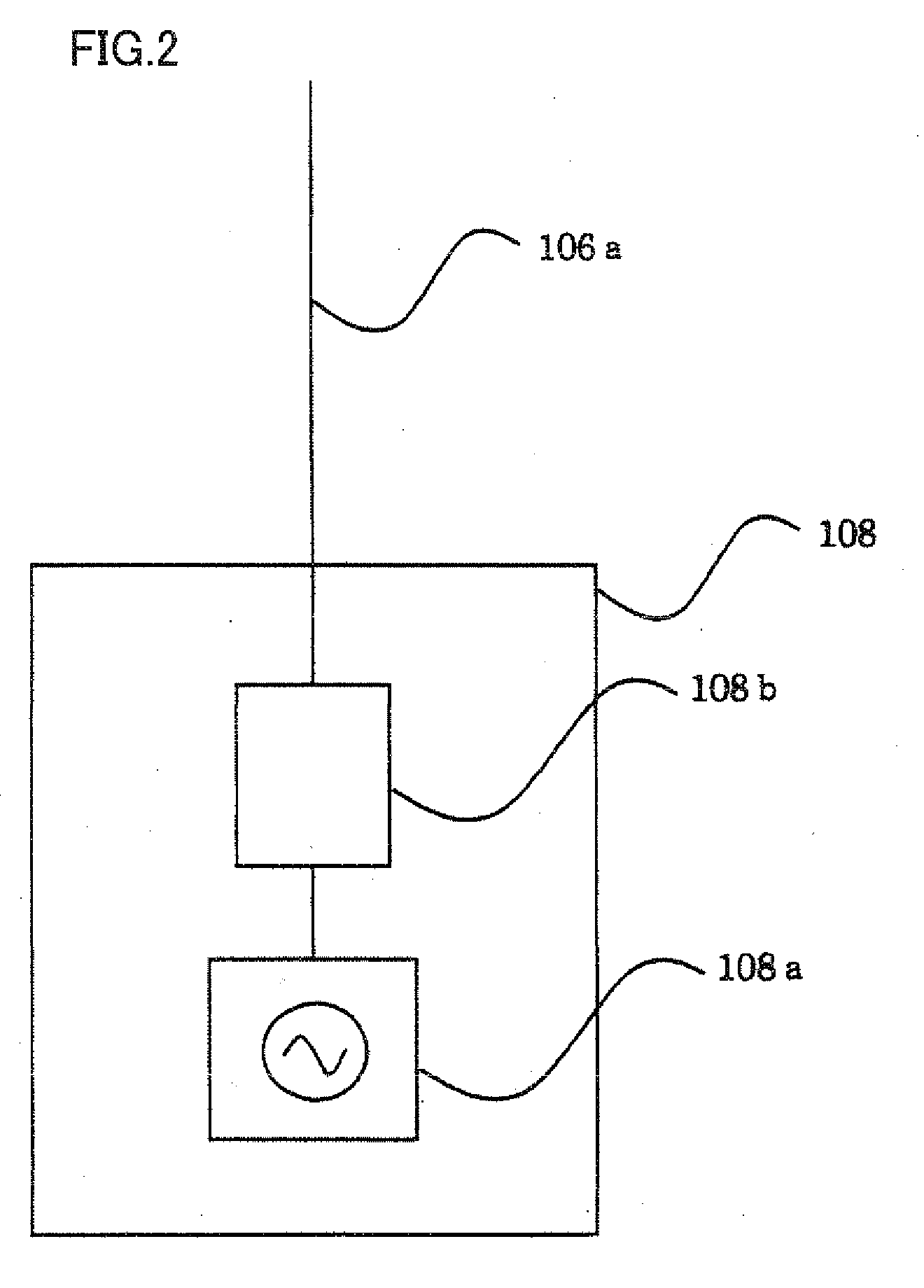Plasma processing apparatus, plasma processing method and photoelectric conversion element
a plasma processing and plasma technology, applied in the direction of sustainable manufacturing/processing, final product manufacturing, coatings, etc., can solve the problems of complicated mechanism, unavoidable complex mechanical structure of intermediate chambers, and stoppage of whole production lines, so as to reduce plasma processing speed and reduce time-averaged value of applied power , the effect of easy control of throughpu
- Summary
- Abstract
- Description
- Claims
- Application Information
AI Technical Summary
Benefits of technology
Problems solved by technology
Method used
Image
Examples
first embodiment
[0084]A plasma processing apparatus and method according to this embodiment are configured to deposit semiconductor layers of a thin film amorphous silicon photoelectric conversion element having a pin structure on work 107 by the plasma CVD method in the same plasma reaction chamber 101.
[0085]The p-type amorphous silicon layer and the i-type amorphous silicon layer are deposited using a pulse-modulated AC power as a power supply for the plasma processing (a second plasma processing step), and the n-type amorphous silicon layer is deposited using a CW AC power as a power supply for the plasma processing (a first plasma processing step).
[0086]The p-type amorphous silicon layer can be deposited under the following deposition conditions. The pressure in plasma reaction chamber 101 during the deposition is desirably in a range from 200 Pa to 3000 Pa, and is 400 Pa in this embodiment. A base temperature of a substrate 201 is desirably 250° C. or lower, and is 180° C. in this embodiment. ...
second embodiment
[0099]A plasma processing apparatus and method according to the embodiment execute a plasma CVD step (i.e., a step including a first plasma processing step) of depositing a thin film on work 107 by a plasma CVD method, and a plasma etching step (a second plasma processing step) of etching another work 107 in the same plasma reaction chamber 101.
[0100]The plasma CVD step is merely required to have at least one first plasma processing step using a CW AC power, and may further include a plasma CVD step using a pulse-modulated AC power. The plasma CVD step may be a step of depositing a film of a single layer, may also be a step of depositing a layer of multiple layers. In this embodiment, a film of multiple layers is deposited by the plasma CVD step.
[0101]Conversely, the plasma etching step performs the plasma etching using a pulse-modulated AC power, and a discharge start voltage thereof is higher than that in the first plasma processing step.
[0102]This embodiment will now be described...
third embodiment
[0108]In a plasma processing apparatus and method according to this embodiment, at least two plasma CVD steps of which discharge start voltages are different from each other are executed in the same plasma reaction chamber 101. As an example thereof description will now be given on a plasma processing apparatus and method that deposit a semiconductor layer of a silicon-base thin film photoelectric conversion element.
[0109]It is noted that the effect of the invention that is achieved by the following embodiment can likewise be achieved by such a semiconductor layer forming step of a silicon-base thin film photoelectric conversion element that includes a step of forming an i-type amorphous silicon-base photoelectric conversion layer by a pulse-modulated AC power and a step of forming an i-type crystalline silicon-base photoelectric conversion layer by a CW AC power.
[0110]The plasma processing apparatus implementing the embodiment is similar to that shown in FIG. 1.
[0111]FIG. 4 is a sc...
PUM
| Property | Measurement | Unit |
|---|---|---|
| Pressure | aaaaa | aaaaa |
| Speed | aaaaa | aaaaa |
| Electric potential / voltage | aaaaa | aaaaa |
Abstract
Description
Claims
Application Information
 Login to View More
Login to View More - R&D
- Intellectual Property
- Life Sciences
- Materials
- Tech Scout
- Unparalleled Data Quality
- Higher Quality Content
- 60% Fewer Hallucinations
Browse by: Latest US Patents, China's latest patents, Technical Efficacy Thesaurus, Application Domain, Technology Topic, Popular Technical Reports.
© 2025 PatSnap. All rights reserved.Legal|Privacy policy|Modern Slavery Act Transparency Statement|Sitemap|About US| Contact US: help@patsnap.com



